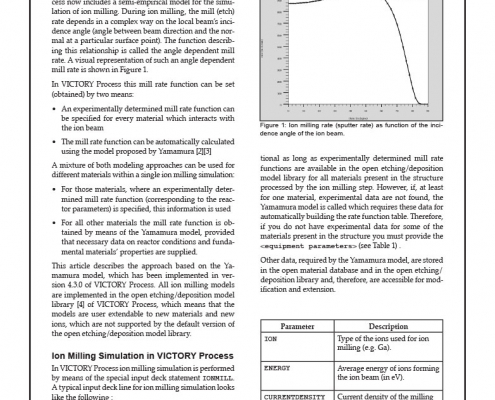
A Semi-Empirical Model for the Simulation of Ion Milling in VICTORY Process
The three-dimensional process simulator VICTORY Process now includes a semi-empirical model for the simulation of ion milling. During ion milling, the mill (etch) rate depends in a complex way on the local beam’s incidence angle (angle between beam direction and the normal at a particular surface point). The function describing this relationship is called the angle dependent mill rate. A visual representation of such an angle dependent mill rate is shown in Figure 1.
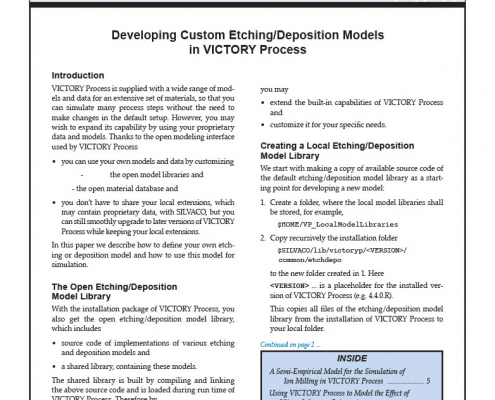
Developing Custom Etching/Deposition Models in VICTORY Process
VICTORY Process is supplied with a wide range of models and data for an extensive set of materials, so that you can simulate many process steps without the need to make changes in the default setup. However, you may wish to expand its capability by using your proprietary data and models. Thanks to the open modeling interface used by VICTORY Process
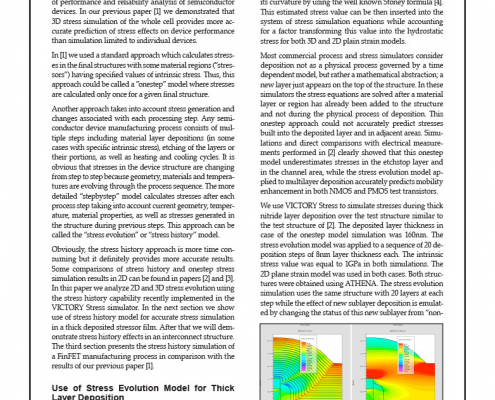
Simulation of Stress Evolution During Semiconductor Device Fabrication
Accurate stress simulation has become a necessary part of performance and reliability analysis of semiconductor devices. In our previous paper [1] we demonstrated that 3D stress simulation of the whole cell provides more accurate prediction of stress effects on device performance than simulation limited to individual devices.
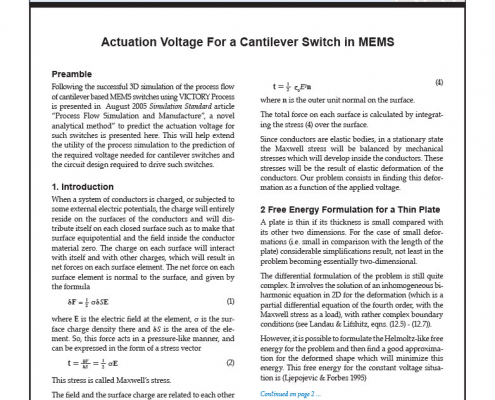
Actuation Voltage For a Cantilever Switch in MEMS
Following the successful 3D simulation of the process flow of cantilever based MEMS switches using VICTORY Process is presented in August 2005 Simulation Standard article “Process Flow Simulation and Manufacture”, a novel analytical method to predict the actuation voltage for such switches is presented here. This will help extend the utility of the process simulation to the prediction of the required voltage needed for cantilever switches and the circuit design required to drive such switches.
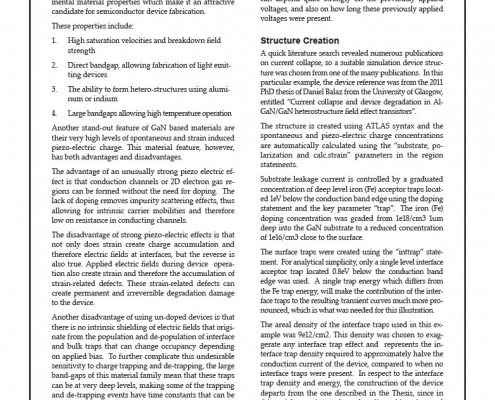
Current Collapse Phenomenon in GaN HFETs resulting from Intentional Bulk Iron (Fe) Doping and Un-intentional Interface Traps
The Gallium Nitride-based material family has fundamental material properties which make it an attractive candidate for semiconductor device fabrication.
These properties include:
High saturation velocities and breakdown field strength
Direct bandgap, allowing fabrication of light emitting devices
The ability to form hetero-structures using aluminum or indium
Large bandgaps allowing high temperature operation
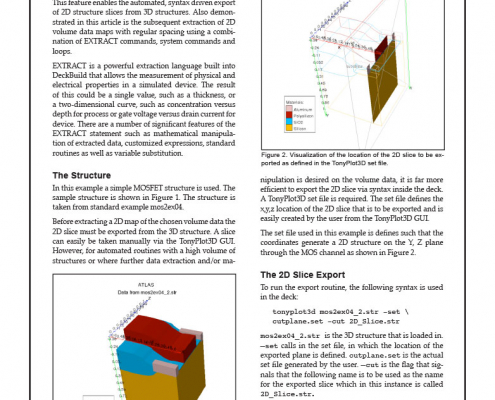
Syntax Driven 2D Structure Export from 3D Structures and Extraction of 2D Volume Data Maps
This article demonstrates a new feature of TonyPlot3D. This feature enables the automated, syntax driven export of 2D structure slices from 3D structures. Also demonstrated in this article is the subsequent extraction of 2D volume data maps with regular spacing using a combination of EXTRACT commands, system commands and loops.

Leakage Current Calibration Procedures of Amorphous Silicon Thin-Film Transistors
Amorphous silicon Thin-Film Transistors (a-Si TFTs) are widely used as the switching device of liquid crystal display (LCD) technology. For development and analysis of a-Si TFTs, many research groups are trying to understand the physical mechanisms of a-Si TFTs. In particular, leakage current behavior is a major consideration for switching devices like a-Si TFTs. To analyze the leakage current mechanisms, calibration with numerical simulation is required.
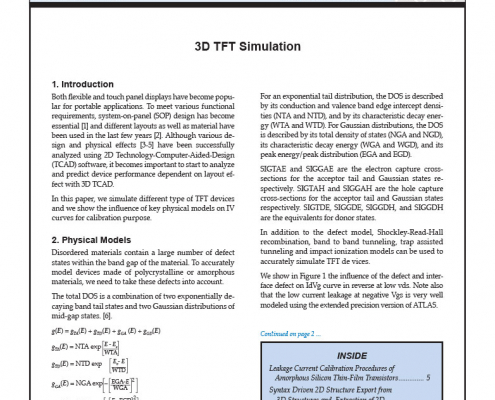
3D TFT Simulation
Both flexible and touch panel displays have become popular for portable applications. To meet various functional requirements, system-on-panel (SOP) design has become essential [1] and different layouts as well as material have been used in the last few years [2]. Although various design and physical effects [3-5] have been successfully analyzed using 2D Technology-Computer-Aided-Design (TCAD) software, it becomes important to start to analyze and predict device performance dependent on layout effect with 3D TCAD.
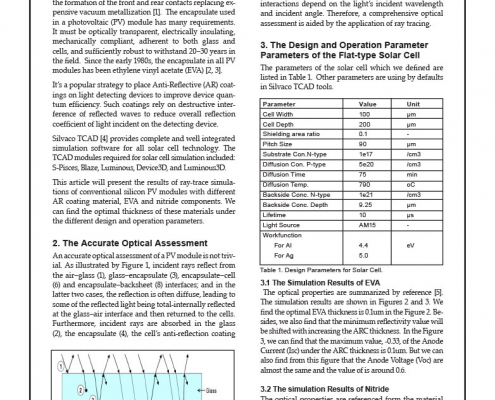
The Studies of Anti-Reflective (AR) Coatings Effects for Solar Cell by Using Silvaco TCAD Tools
In 1975, screen printing was first applied to solar cells for the formation of the front and rear contacts replacing expensive vacuum metallization [1]. The encapsulate used in a photovoltaic (PV) module has many requirements. It must be optically transparent, electrically insulating, mechanically compliant, adherent to both glass and cells, and sufficiently robust to withstand 20–30 years in the field. Since the early 1980s, the encapsulate in all PV modules has been ethylene vinyl acetate (EVA) [2, 3].
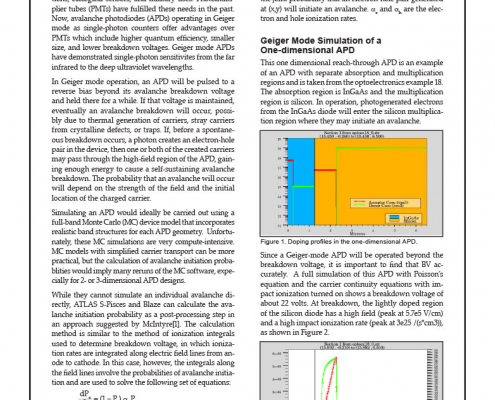
Geiger Mode Simulation of Avalanche Photodiodes in ATLAS
Single-photon counting detectors are used in a wide range of applications, including astronomy, optical communications, biological sensors, and military uses. Photomultiplier tubes (PMTs) have fulfilled these needs in the past. Now, avalanche photodiodes (APDs) operating in Geiger mode as single-photon counters offer advantages over PMTs which include higher quantum efficiency, smaller size, and lower breakdown voltages. Geiger mode APDs have demonstrated single-photon sensitivites from the far infrared to the deep ultraviolet wavelengths.
